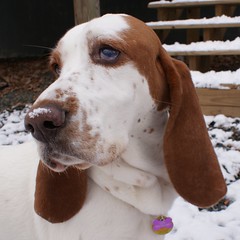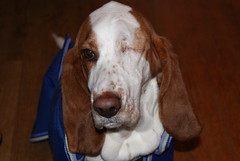Progressive Retinal Atrophy, known as PRA, is a genetic eye disease in dogs similar to retinitis pigmentosa in humans.
The condition was first discovered in Gordon Setters, but has been found in many breeds including Cockers, Poodles, Labradors, Schnauzers, Old English Sheepdogs and many others. It's a disease of the retina that usually starts out as night blindness where the animal has trouble seeing in low light conditions and progresses to total blindness.
In most breeds the condition is inherited as a recessive trait. Siberian Huskies and Bullmastiffs are exceptions, as it is dominantly inherited in those breeds. There is no treatment for the condition and blindness is the usual result.
The condition was discovered in Portuguese Water Dogs in the late 1970s. Veterinarians, scientists and the dog breeding community took action to find the cause and the offending gene was located. There is now a test available from Optigen to determine if a dog carries the gene.
Dogs are rated as clear, carriers or affected. Dogs affected will become blind. Carriers can safely be bred to a clear dog. The resulting puppies can be carriers, but will not develop the disease. It's important for breeders to test their breeding dogs and be careful when breeding in order to control the spread of the disease. Breeding dogs should also be checked by a canine opthalmologists yearly to be sure they are free of symptoms. The exam is painless. They are then certified by CERF, the Canine Eye Registration Foundation.
When buying a purebred puppy, talk with the breeder about PRA in the breed. Ask questions about the breeders experience with the disease. Ask for the ratings of the parents and request copies of the CERF and Optigen certificates. Responsible breeders will be happy to give you the certificates and answer any questions. Breeders who care about their breed try to produce healthy puppies and eliminate health issues wherever possible.
In our pack, Samba is a PRA carrier. We had her tested when she was quite young and she saw an opthalmologist each year prior to breeding. Fudge is clear of the disease. It was safe to breed the pair and none of our pups will go blind from this heartbreaking disease. I sent copies of their cetrtificates to any prospective buyers.
For additional information on PRA and to answer questions about PRA in your breed, here are some informative sites to check out. Also ask your vet if you would like to know more about the disease in your breed.
Animal Eye Care
Optigen
CERF
Thursday, February 24, 2011
Thursday, February 17, 2011
Glaucoma and your dog
This isn’t an easy post to write. We pride ourselves on being not just good, but involved, devoted, educated, aware dog owners, so having a young – three years old – dog show up with aggressive glaucoma in one eye over Christmas was devastating. The other eye has been checked and also has primary (genetic) glaucoma and its untreated pressure did touch on the lower end of the glaucoma/ eye pressure range.
 After spending a month in survival mode – for the humans, not the eye… we lost that fight probably before we even knew we were at war – it was time to educate ourselves on canine glaucoma so we are fully equipped to face the almost inevitable day when the remaining eye also spikes into that dangerous, damaging pressure range. Now that we know the basics, it’s time to pass them along, and hopefully help someone else spot the warning signs faster, and in time to save both eyes. (Photo taken 12-26-10)
After spending a month in survival mode – for the humans, not the eye… we lost that fight probably before we even knew we were at war – it was time to educate ourselves on canine glaucoma so we are fully equipped to face the almost inevitable day when the remaining eye also spikes into that dangerous, damaging pressure range. Now that we know the basics, it’s time to pass them along, and hopefully help someone else spot the warning signs faster, and in time to save both eyes. (Photo taken 12-26-10)
I have to pause here to be sure everyone knows we have the best vets – not just in my opinion, but according to the AAHA’s accreditation – around, and Sissy – our one eyed-girl – has very regular visits for her allergies. We didn’t miss anything; primary glaucoma is just that hard-hitting. In fact, we’re very lucky that our veterinary practice has specialized eye care equipment and the vet we saw on December 27th trusted her hunch and checked those eye pressures.
 While our eye surgeon is working on an article to share with any of our doggie friends who want to publish a little something on their blogs, in their rescue or breed groups’ newsletters, etc., I’ve cobbled together a little something on what to look for. I must stress that early intervention is critical, so if you see ANY of these signs, please don’t delay and call the vet right away.
While our eye surgeon is working on an article to share with any of our doggie friends who want to publish a little something on their blogs, in their rescue or breed groups’ newsletters, etc., I’ve cobbled together a little something on what to look for. I must stress that early intervention is critical, so if you see ANY of these signs, please don’t delay and call the vet right away.
Rubbing the eyes
Redness in the whites of the eyes
Any deformity of the eye (an advanced symptom)
Cloudiness of the eye (also advanced)
Excessive blinking and/or tearing
Bumping into things or suddenly refusing to jump up or down off of familiar spots (also advanced)
You can see why we didn’t rush to the vet when these symptoms appeared in our allergic to the world girl on Christmas Eve. (There was no deformity or cloudiness until January 1, after treatment had begun.) If you have a dog with allergies, I’d still recommend talking to your vet about glaucoma and general eye health, because I haven’t touched on – and am not well-versed on – secondary glaucoma, which is caused by something other than bad genes, such as trauma or untreated eye conditions.

Sissy has given me permission to share all photos within this post, some of which have not been posted in blogland before, because she really does want to help other dogs avoid the serious pain glaucoma causes, along with the torture of lifelong eye drops daily, not to mention the sad surgery… I haven’t sited sources, but if you want or need more information, I can share my saved favorites upon request.
 After spending a month in survival mode – for the humans, not the eye… we lost that fight probably before we even knew we were at war – it was time to educate ourselves on canine glaucoma so we are fully equipped to face the almost inevitable day when the remaining eye also spikes into that dangerous, damaging pressure range. Now that we know the basics, it’s time to pass them along, and hopefully help someone else spot the warning signs faster, and in time to save both eyes. (Photo taken 12-26-10)
After spending a month in survival mode – for the humans, not the eye… we lost that fight probably before we even knew we were at war – it was time to educate ourselves on canine glaucoma so we are fully equipped to face the almost inevitable day when the remaining eye also spikes into that dangerous, damaging pressure range. Now that we know the basics, it’s time to pass them along, and hopefully help someone else spot the warning signs faster, and in time to save both eyes. (Photo taken 12-26-10)I have to pause here to be sure everyone knows we have the best vets – not just in my opinion, but according to the AAHA’s accreditation – around, and Sissy – our one eyed-girl – has very regular visits for her allergies. We didn’t miss anything; primary glaucoma is just that hard-hitting. In fact, we’re very lucky that our veterinary practice has specialized eye care equipment and the vet we saw on December 27th trusted her hunch and checked those eye pressures.
 While our eye surgeon is working on an article to share with any of our doggie friends who want to publish a little something on their blogs, in their rescue or breed groups’ newsletters, etc., I’ve cobbled together a little something on what to look for. I must stress that early intervention is critical, so if you see ANY of these signs, please don’t delay and call the vet right away.
While our eye surgeon is working on an article to share with any of our doggie friends who want to publish a little something on their blogs, in their rescue or breed groups’ newsletters, etc., I’ve cobbled together a little something on what to look for. I must stress that early intervention is critical, so if you see ANY of these signs, please don’t delay and call the vet right away.Rubbing the eyes
Redness in the whites of the eyes
Any deformity of the eye (an advanced symptom)
Cloudiness of the eye (also advanced)
Excessive blinking and/or tearing
Bumping into things or suddenly refusing to jump up or down off of familiar spots (also advanced)
You can see why we didn’t rush to the vet when these symptoms appeared in our allergic to the world girl on Christmas Eve. (There was no deformity or cloudiness until January 1, after treatment had begun.) If you have a dog with allergies, I’d still recommend talking to your vet about glaucoma and general eye health, because I haven’t touched on – and am not well-versed on – secondary glaucoma, which is caused by something other than bad genes, such as trauma or untreated eye conditions.

Sissy has given me permission to share all photos within this post, some of which have not been posted in blogland before, because she really does want to help other dogs avoid the serious pain glaucoma causes, along with the torture of lifelong eye drops daily, not to mention the sad surgery… I haven’t sited sources, but if you want or need more information, I can share my saved favorites upon request.
Subscribe to:
Posts (Atom)







